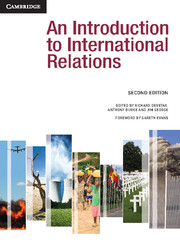Book contents
- Frontmatter
- Contents
- Tables, Figures and Boxes
- Contributors
- Preface and acknowledgements
- An Introduction to International Relations: The origins and changing agendas of a discipline
- 1 Theories of International Relations
- 2 The Traditional Agenda
- 9 The Modern State
- 10 Nations and Nationalism
- 11 Security
- 12 Arms Control
- 13 The Causes of War
- 14 The Changing Character of Warfare
- 15 The Ethics and Laws of War
- 16 International Law
- 17 International Society and European Expansion
- 18 Diplomacy
- 19 Great Powers
- 20 The Cold War
- 3 The New Agenda
- Glossary of Terms
- Bibliography
- Index
- References
20 - The Cold War
from 2 - The Traditional Agenda
- Frontmatter
- Contents
- Tables, Figures and Boxes
- Contributors
- Preface and acknowledgements
- An Introduction to International Relations: The origins and changing agendas of a discipline
- 1 Theories of International Relations
- 2 The Traditional Agenda
- 9 The Modern State
- 10 Nations and Nationalism
- 11 Security
- 12 Arms Control
- 13 The Causes of War
- 14 The Changing Character of Warfare
- 15 The Ethics and Laws of War
- 16 International Law
- 17 International Society and European Expansion
- 18 Diplomacy
- 19 Great Powers
- 20 The Cold War
- 3 The New Agenda
- Glossary of Terms
- Bibliography
- Index
- References
Summary
Introduction
The Cold War was the most important feature of the international system in the second half of the twentieth century. The rivalry between the Soviet Union (USSR) and the United States (US) shaped the contours of conflict and cooperation among states and peoples between 1945 and 1991. Although the conflict did not drive all aspects of international relations, its force permeated every corner of the globe. Whether in Santiago, Sydney or Shanghai, the influence of geopolitical and ideological conflict was unmistakable. More importantly, the Cold War created rivalries and political fault lines which continue to shape international relations long after the conflict has passed.
The Cold War was a conflict between the USSR and the US (see Box 20.1). The two powers who emerged from World War II as preeminent in world politics became engaged in a protracted global contest which, although actual combat between them never eventuated, involved the largest and most destructive military arsenals in history. The two camps could destroy the entire planet thousands of times over with their nuclear weapons, and each side’s military was on a hair trigger for the conflict’s duration. It was a dispute that was driven both by traditional concerns about security – each felt the other threatening to their survival and their interests – as well as by ideological antagonism. Both embodied universal ideologies which assumed the superiority of their social system over all others. In this respect the Cold War was as much a contest about how to organise society as it was a competition for strategic influence and nuclear superiority.
- Type
- Chapter
- Information
- An Introduction to International Relations , pp. 281 - 294Publisher: Cambridge University PressPrint publication year: 2011



